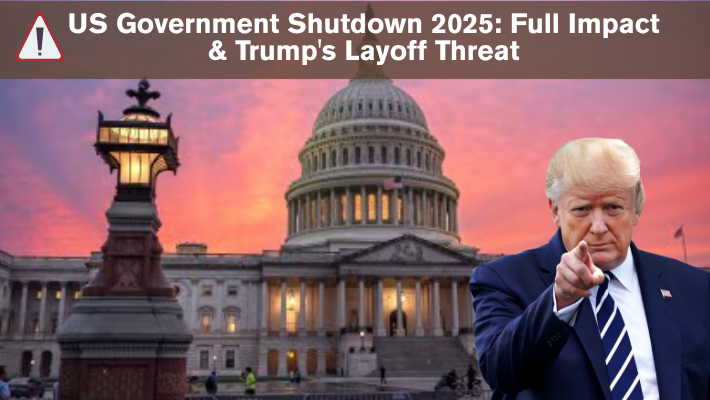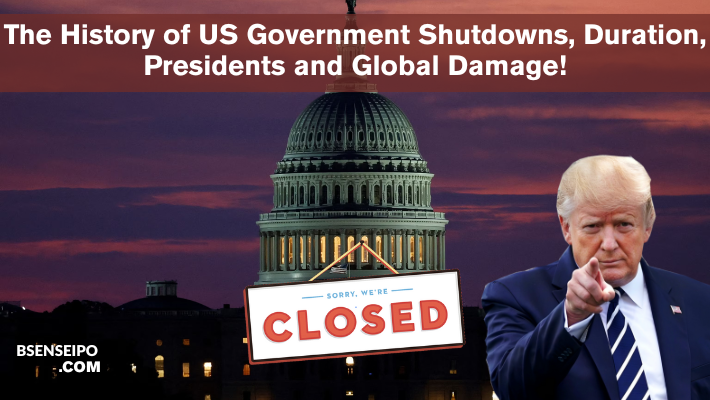US Government Shutdown 2025: Why It Happened, Full Impact & Trump’s Layoff Threat
For the first time in six years, the US federal government has officially entered a shutdown, halting all non-essential operations as of midnight, October 1, 2025.1 This impasse is not the typical squabble over total spending, but a high-stakes confrontation centered on healthcare funding.
The deadlock began when congressional Democrats refused to support a short-term funding bill unless it included provisions to address the soaring healthcare costs resulting from the administration’s recent policies. Specifically, Democrats demanded:
- Extension of Expiring Affordable Care Act (ACA) Subsidies: The lapse of these subsidies has led to significant spikes in insurance premiums for millions of Americans.
- Reversal of Medicaid Cuts: Cuts introduced in the administration’s large domestic spending and tax package earlier this year.
Republicans, supported by the White House, insisted on a “clean” Continuing Resolution (CR) that funds the government without addressing these healthcare policy demands. With neither side willing to yield, the funding deadline was breached, forcing the government to close.
The Immediate and Long-Term Impact
A government shutdown, whether partial or full, sends hundreds of thousands of federal workers home and disrupts services relied upon by millions of citizens.
| Affected Area | Immediate Impact | Long-Term Concern |
| Federal Workers | Approximately 750,000 employees are furloughed without pay or are deemed “essential” and must work without immediate pay (e.g., Border Protection, Air Traffic Control, active-duty military). | This shutdown could lead to permanent layoffs. The Office of Management and Budget (OMB) has directed agencies to prepare “Reduction-in-Force” (RIF) notices to permanently eliminate jobs in programs inconsistent with the administration’s priorities. |
| Economic Growth | Economists estimate each week of a shutdown could trim 0.1 to 0.2 percentage points from US economic growth. | Private-sector entities that rely on federal contracts or activity may never recover lost income. The delay of key federal economic data, like the monthly jobs report, adds uncertainty for investors. |
| Public Services | National Parks and museums are closed. Routine regulatory inspections (e.g., Food and Drug Administration) are suspended. Services like processing student loans, veteran claims, and passport applications face severe delays. | Increased public health risks due to suspended inspections and environmental damage at unstaffed national parks. Exacerbation of backlogs in immigration courts and other essential services. |
| Entitlement Programs | Social Security, Medicare, and Medicaid checks are generally still distributed as they are funded through permanent appropriations. | While checks go out, services like benefit verification, new card issuance, and claims processing for new applicants are suspended or delayed. |
The Trump Administration’s Role: A New Twist on Shutdowns
The current shutdown is the first since the administration’s return to the White House, and its approach signals a dramatic shift from previous closures.
Weaponizing the Shutdown:
President Donald Trump and his officials have framed the shutdown not as a failure, but as an opportunity to implement his agenda of shrinking the federal government.9 He has threatened mass firings of federal workers, stating that the furloughed employees would be primarily “Democrats” and that the administration could “do things that are irreversible, that are bad for them.”
The Reduction-in-Force (RIF) Threat:
The OMB memo directing agencies to draft RIF plans is a significant departure from previous shutdowns, which only involved temporary furloughs.11 This threat of permanent job elimination has outraged federal employee unions, who accuse the administration of treating workers as “pawns for the president’s political games.”
Partisan Messaging and Blame:
Federal agencies, at the direction of the White House, have used official government communications, including website banners, to explicitly blame Democrats for the closure.13 The messaging argues the Democrats are holding the government hostage with “insane policy demands,” a move that has raised questions about potential violations of the Hatch Act, which restricts partisan political activity by federal employees.
Conclusion: A Crisis with High Stakes
This government shutdown is not just a budget hiccup; it is a high-stakes political power struggle over core domestic policy—chiefly healthcare. The immediate impact is clear: nearly a million workers face financial uncertainty, and public services are crumbling. However, the true threat lies in the administration’s willingness to use the funding lapse as a political tool to permanently downsize the federal workforce, potentially reshaping the government’s scope and function long after the funding is restored.
The ball remains in Congress’s court, but with the political rhetoric escalating and the administration digging in its heels, a swift resolution appears unlikely. The nation must now brace for a potentially prolonged standoff where the economic and social costs will continue to mount.




